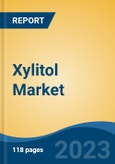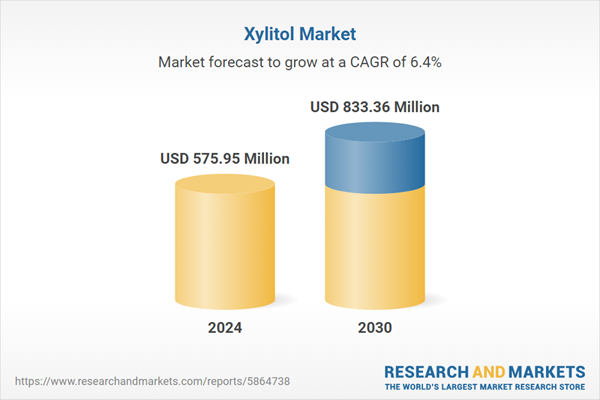Speak directly to the analyst to clarify any post sales queries you may have.
10% Free customizationThis report comes with 10% free customization, enabling you to add data that meets your specific business needs.
The market is poised for considerable growth, fueled by increasing demand for natural and functional ingredients, the rising prevalence of chronic conditions including diabetes and obesity, and the broadening scope of xylitol applications across various industries. Companies that prioritize product innovation, ethical and sustainable raw material sourcing, and targeted market expansion strategies are positioned to leverage these evolving market dynamics effectively.
Key Market Drivers
Increasing Prevalence of Diabetes and Obesity
The escalating global incidence of diabetes and obesity stands out as a critical market driver propelling the demand for xylitol, a natural sugar substitute that addresses significant health concerns associated with these conditions. This trend is shaping consumer behavior, influencing regulatory frameworks, and reshaping product development strategies across the food, beverage, pharmaceutical, and personal care industries. Diabetes and obesity are closely linked to excessive intake of sugar and high-calorie diets.These chronic conditions increase the risk of cardiovascular diseases, metabolic disorders, and other health complications, prompting both consumers and healthcare providers to seek safer dietary alternatives. Cardiovascular diseases (CVD) represent the primary cause of mortality and morbidity among individuals with diabetes, especially those diagnosed with type 2 diabetes. The incidence of CVD within this population is markedly elevated compared to the public, with prevalence rates reported between 14.8% and 40.5%. Xylitol, with its low glycemic index and reduced caloric content compared to sucrose, offers an effective solution by providing sweetness without adversely impacting blood sugar levels.
In 2021, approximately 537 million adults aged 20 to 79 equivalent to 10.5% of the global adult population were living with diabetes. Forecasts project a significant rise in diabetes prevalence, with the number of affected individuals expected to reach 643 million by 2030 and escalate further to 783 million by 2045. The expanding population of diabetic and overweight individuals worldwide has intensified demand for products that support blood sugar management and weight control. Food manufacturers and pharmaceutical companies increasingly incorporate xylitol into sugar-free confectioneries, baked goods, oral care products, and medicinal formulations to cater to this demographic.
Xylitol’s ability to replicate the taste and functional properties of sugar without the associated health risks makes it a preferred ingredient in diabetic-friendly and low-calorie product lines. There is a notable shift among consumers towards preventive health and wellness, with a growing emphasis on diet-based management of obesity and diabetes. This shift drives the adoption of sugar alternatives like xylitol that contribute to healthier lifestyles. Increased awareness campaigns and educational initiatives by health organizations have further elevated consumer knowledge about the benefits of sugar alcohols, enhancing market acceptance.
Governments and regulatory bodies worldwide are encouraging the reduction of sugar consumption through policy measures and dietary guidelines. This regulatory environment motivates manufacturers to innovate and reformulate products with sugar substitutes such as xylitol. Enhanced research and development efforts have led to improved xylitol production techniques and novel applications, expanding its use in functional foods and pharmaceuticals aimed at diabetic and obese populations.
Key Market Challenges
High Production Costs and Complex Manufacturing Process
One of the primary challenges limiting the widespread adoption of xylitol is its relatively high production cost compared to conventional sweeteners like sucrose or high-fructose corn syrup. Xylitol production involves complex, multi-step chemical or enzymatic processes often requiring specialized raw materials such as birch wood, corn cobs, or sugar beet fibers and significant energy input. This complexity not only increases manufacturing expenses but also impacts scalability, resulting in higher prices for end consumers. For price-sensitive markets, especially in developing regions, the elevated cost of xylitol-containing products can restrict demand and limit market penetration.Key Market Trends
Integration of Xylitol in Clean Label and Plant-Based Products
The clean label movement, emphasizing transparency, natural ingredients, and minimal processing, is gaining strong momentum globally. Consumers increasingly demand products with recognizable, plant-derived components and without artificial additives. Xylitol, derived from natural sources such as birch wood and corn fiber, aligns well with this trend. Its inclusion in plant-based and organic food and beverage products is expanding, especially in sugar-free confectionery, dairy alternatives, and functional snacks. This integration not only enhances product appeal among health-conscious and environmentally aware consumers but also stimulates innovation in natural sweetener blends that include xylitol to optimize taste and functionality.Key Market Players
- Cargill, Incorporated
- DuPont de Nemours, Inc
- Roquette Frères
- Thomson Biotech Corporation
- Nova Green Inc.
- Zhejiang Huakang Pharmaceutical Co., Ltd
- Foodchem International Corporation
- A & Z Food Additives Co., Ltd
- Herboveda India
- Godavari Biorefineries Ltd
Report Scope:
In this report, the Global Xylitol Market has been segmented into the following categories, in addition to the industry trends which have also been detailed below:Xylitol Market, By Form:
- Powder
- Liquid
Xylitol Market, By Application:
- Chewing Gum
- Confectionery
- Bakery & Other Foods
- Oral Care
- Others
Xylitol Market, By Region:
- North America
- United States
- Canada
- Mexico
- Europe
- France
- United Kingdom
- Italy
- Germany
- Spain
- Asia-Pacific
- China
- India
- Japan
- Australia
- South Korea
- South America
- Brazil
- Argentina
- Colombia
- Middle East & Africa
- South Africa
- Saudi Arabia
- UAE
Competitive Landscape
Company Profiles: Detailed analysis of the major companies present in the Global Xylitol Market.Available Customizations:
With the given market data, the publisher offers customizations according to a company's specific needs. The following customization options are available for the report.Company Information
- Detailed analysis and profiling of additional market players (up to five).
This product will be delivered within 1-3 business days.
Table of Contents
Companies Mentioned
The leading companies profiled in this Xylitol market report include:- Cargill, Incorporated
- DuPont de Nemours, Inc
- Roquette Frères
- Thomson Biotech Corporation
- Nova Green Inc.
- Zhejiang Huakang Pharmaceutical Co., Ltd
- Foodchem International Corporation
- A & Z Food Additives Co., Ltd
- Herboveda India
- Godavari Biorefineries Ltd
Table Information
| Report Attribute | Details |
|---|---|
| No. of Pages | 180 |
| Published | September 2025 |
| Forecast Period | 2024 - 2030 |
| Estimated Market Value ( USD | $ 575.95 Million |
| Forecasted Market Value ( USD | $ 833.36 Million |
| Compound Annual Growth Rate | 6.3% |
| Regions Covered | Global |
| No. of Companies Mentioned | 11 |









